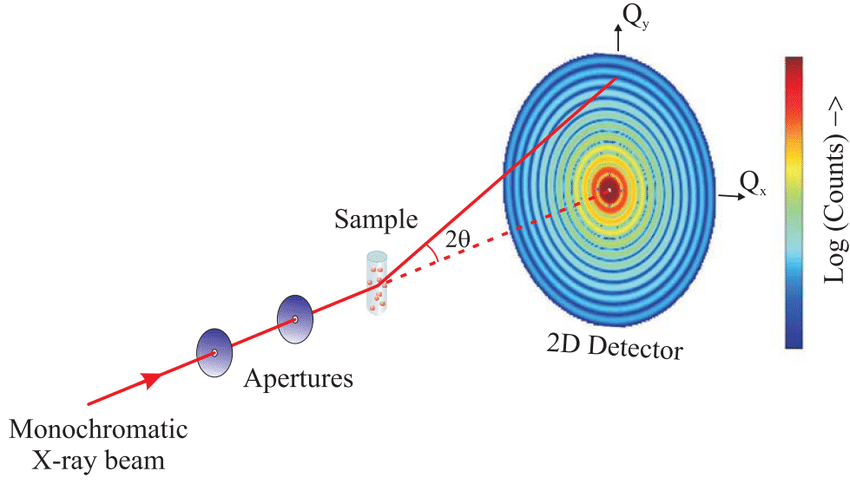Small-Angle X-ray Scattering (SAXS): Probing Nanoscale Structures of Materials and Biomolecules
What is Small-Angle X-ray Scattering?
Small-Angle X-ray Scattering (SAXS) is a powerful analytical technique used to study the structural properties of materials at the nanoscale. It involves the elastic scattering of X-rays by a sample at very small angles, typically in the range of 0.1 to 10 degrees. By analyzing the scattered X-rays, researchers can obtain detailed information about the size, shape, and internal structure of nanoscale objects, such as nanoparticles, proteins, and polymers.

Key Concepts in SAXS
SAXS relies on several key concepts to provide insights into the nanoscale structure of materials:
Elastic Scattering
In SAXS, the X-rays are elastically scattered by the sample, meaning that the energy of the X-rays remains unchanged during the scattering process. The scattered X-rays carry information about the spatial variations in electron density within the sample, which can be related to the nanoscale structure.
Scattering Vector
The scattering vector, denoted as q, is a crucial parameter in SAXS. It represents the difference between the incident and scattered wave vectors and is inversely related to the length scale probed in the sample. By measuring the scattered intensity as a function of q, researchers can obtain a scattering profile that contains structural information at different length scales.
Form Factor and Structure Factor
The scattering profile in SAXS can be described by two main contributions: the form factor and the structure factor. The form factor provides information about the shape and size of individual scattering objects, such as nanoparticles or proteins. The structure factor, on the other hand, arises from the spatial arrangement and interactions between the scattering objects.
Advantages of SAXS
SAXS offers several advantages over other techniques for studying nanoscale structures:
- Non-destructive: SAXS is a non-destructive technique, allowing the sample to be investigated without causing damage or alteration.
- In-situ measurements: SAXS can be performed in various sample environments, enabling in-situ studies of structural changes under different conditions, such as temperature, pressure, or chemical reactions.
- Ensemble averaging: SAXS provides ensemble-averaged structural information, making it suitable for studying systems with a large number of nanoscale objects or polydisperse samples.
- Complementary to other techniques: SAXS can be combined with other techniques, such as microscopy or spectroscopy, to obtain a comprehensive understanding of the sample's structure and properties.
Applications of SAXS
SAXS finds applications in a wide range of scientific fields, including materials science, biology, and nanotechnology:
Nanoparticle Characterization
SAXS is widely used to characterize the size, shape, and internal structure of nanoparticles. It can provide information about the size distribution, polydispersity, and surface properties of nanoparticles in solution or embedded in a matrix.
Protein Structure Analysis
SAXS is a valuable tool for studying the structure and conformational changes of proteins in solution. It can provide low-resolution structural information, such as the overall shape, dimensions, and oligomeric state of proteins, which is complementary to high-resolution techniques like X-ray crystallography and NMR spectroscopy.
Polymer and Soft Matter Characterization
SAXS is extensively used to study the structure and dynamics of polymers, colloids, and other soft matter systems. It can provide insights into the conformation of polymer chains, the morphology of block copolymers, and the interactions between colloidal particles.
Data Analysis and Modeling
Interpreting SAXS data requires advanced data analysis and modeling techniques. The scattered intensity is typically plotted as a function of the scattering vector q, resulting in a scattering profile. Various data analysis approaches, such as Guinier analysis, Porod analysis, and pair distance distribution function analysis, are used to extract structural parameters from the scattering profile.
Modeling of SAXS data involves fitting the experimental scattering profile with theoretical models that describe the expected scattering from specific geometric shapes or structures. This process allows researchers to obtain quantitative information about the size, shape, and internal structure of the nanoscale objects in the sample.
Future Perspectives
SAXS continues to evolve with advancements in instrumentation, data analysis, and modeling techniques. The development of high-brilliance X-ray sources, such as synchrotrons and free-electron lasers, has greatly enhanced the capabilities of SAXS experiments, enabling time-resolved studies and investigations of weakly scattering samples.
The integration of SAXS with complementary techniques, such as small-angle neutron scattering (SANS), wide-angle X-ray scattering (WAXS), and microscopy, is becoming increasingly important for obtaining a comprehensive understanding of nanoscale structures and their properties. Furthermore, the application of machine learning and artificial intelligence techniques in SAXS data analysis and modeling is expected to accelerate the interpretation of complex scattering patterns and the discovery of new structural insights.
Further Reading
Chemical Reviews, Small Angle X-ray Scattering for Nanoparticle Research
Nature Reviews Methods Primers, Small-angle X-ray and neutron scattering
Current Research in Structural Biology, Methods, development and applications of small-angle X-ray scattering to characterize biological macromolecules in solution
